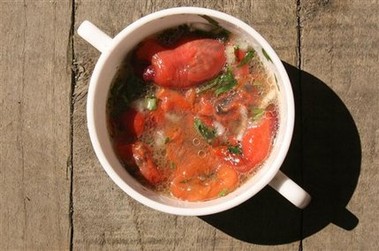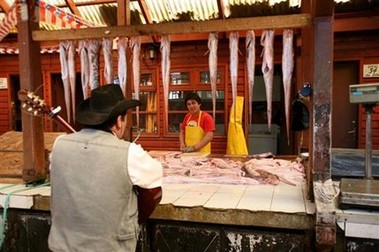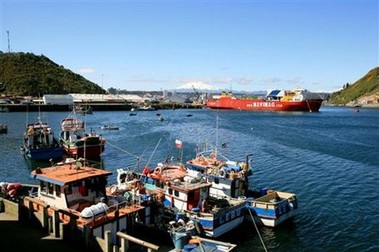Chilean seafood sojourn, hold the salmon
October 16, 2007 - ASAP / Associated Press

PUERTO MONTT, Chile
Though the rubber-booted fish farmers known as salmoneros are a big part of the reason this once-languishing southern city has become something of an industrial boomtown, its inhabitants still favor the local specialties its seafood industry was founded upon.
 A guitar player takes a moment to chat with a fishmonger inside the main hall of El Mercado TÃpico Angelmo in the city of Puerto Montt, Chile.(AP/Joe Ray)
A guitar player takes a moment to chat with a fishmonger inside the main hall of El Mercado TÃpico Angelmo in the city of Puerto Montt, Chile.(AP/Joe Ray)For the last 30 years, the controversial Chilean salmon farming industry has exploded, with Puerto Montt at its core. Though the fish is not native to local waters, Chile’s pristine aquatic conditions have made the country one of the world’s leading salmon exporters, now running neck-and-neck with Norway.
Despite this, at Puerto Montt’s El Mercado TÃpico Angelmo seafood market, the traditional, local seafood, which to the uninitiated can be both sublime and near-alien, does a strong job of duking it out with big business.
Look out at the harbor from the market on any given day, and in the foreground, tiny fishermen’s boats often use horse-drawn carts to load and unload their wares at quayside.
 Boats at anchor just outside of El Mercado TÃpico Angelmo in the city of Puerto Montt, Chile. Fueled by big industry, salmon faming has fueled a huge boom in the town, but more typical regional products and dishes have seen a recent resurgence.(AP/Joe Ray)
Boats at anchor just outside of El Mercado TÃpico Angelmo in the city of Puerto Montt, Chile. Fueled by big industry, salmon faming has fueled a huge boom in the town, but more typical regional products and dishes have seen a recent resurgence.(AP/Joe Ray)Further out in the Reloncavà Sound, however, salmon industry installations dwarf the efforts of the little guy.
SWIMMING UPSTREAM
The market is a riot of color and activity, all centered around seafood. Outside, groups of women sit in the sun and sell dried, smoked mussels and sip maté together while, between every few fish stalls, workers huddle around tiny fire pits to warm their hands and feet.
As I walk into the market’s main hall, hawkers, smelling a foreigner, shout “Salmones! Salmones!” and try to pull me toward their stall.
Mention salmon to Erica CÃ rcamo, a cook at one of the many clam-shack style kiosks that dot the market, and she puckers her face. It’s clearly not her favorite dish.
“People from out of town like salmon,” she says in a matter-of-fact tone, “but locals don’t really want it.”
Instead, they hunt out regional delicacies like sea urchin and hake (a cod relative) or wildly unique bottom dwellers like the iodine- and iron-rich piure, a hermaphroditic filter-feeder which looks like a living roasted red pepper; and a prehistoric-looking barnacle called the picoroco.
Depending on the season, there’s also a kitchen-sink dish called curanto, which originated on the nearby island of Chiloé and is traditionally cooked in an underground pit, clam-bake style. Cà rcamo’s version is a classic, containing everything from mussels, clams and abalone to chicken, chorizo and smoked pork. As I talk with her, two friends who work in the city center sit down at her kiosk and tuck into two whopping plates of curanto as part of a once-a-week-ritual.
Ironically, a resurgence of the locally favored products is partially due to the export success of mass-market species—and the subsequent efforts to prevent overfishing.
“From September through December of every year is a period called the veda (ban),” explains Sylvia Oyarzo, who represents about 150 vendors as the market’s syndicate president. In essence, Oyarzo explains that “during the veda, fishing for popular species ... is halted.”
“The large industrial groups can survive this period,” she explains, but the little guys can’t.
How do they make it?
“They return to the typical regional products like the picoroco, abalone, sea urchin and piure,” she says, listing some of the seafood not affected by the ban (abalone is often subject, but not at the time of this visit). “Here, people are now eating more of these products.”
___
THE WORLD IS YOUR PIURE
Back with cook CÃ rcamo, everything in her kiosk is served with a blunt simplicity that makes little sense until I think of New England’s clam shacks where an order of fried clams is just that, in paper box. Fried hake, CÃ rcamo’s favorite, is served with lemon and a couple slices of beet while the piure is served raw in a two-handled cup with lemon juice, vegetable oil, chopped onion, cilantro and a pinch of salt.
Clearly, I need to try this for myself.
I order a bowl of a seafood soup called paila marina, a few abalones and some piure. One of the waitresses runs into the market for the latter, returning with them in a plastic bag as if they’re goldfish from the pet store. Though there’s piure in the soup, on its own it steals the show—and it reminds me of that famous quote about how the bravest man in the world was the first one to eat an oyster.
Clearly, this man hadn’t tested the breadth and depth of Chilean seafood.
I eat my abalones and soup, nervously pushing the bright-red piure to the back of the plate.
Emboldened by the shot of pisco sour served to every diner before their meal, I dig in and—it’s like a mouthful of iodine. It’s not food you’d want to eat on a first date, but I like it and my tasting notes read, “Weird in a good way.”
Too late, it dawns on me that it would be fantastic with a beer.
Which is enough motivation to try it again.
___
Joe Ray is a Paris-based food and travel writer and photographer currently researching the food and culture of Patagonia. He can be reached via his Web site, http://www.joe-ray.com.